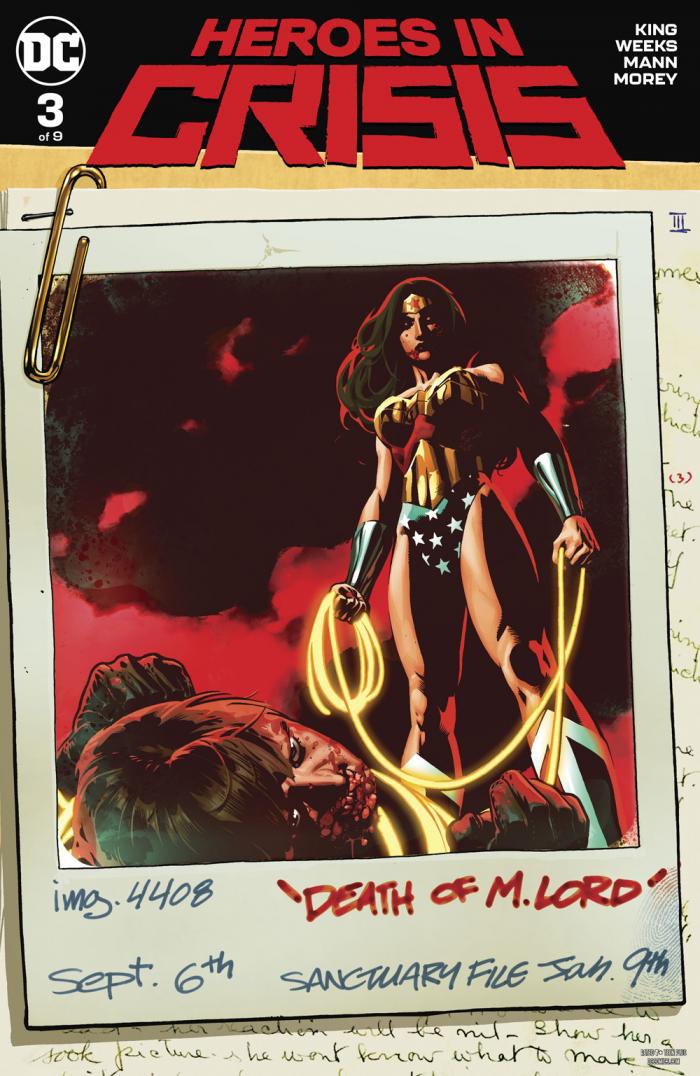You are here
Home › Comics › Heroes in Crisis #3 Returns to the Scene of the Crime and Offers Clues ›Heroes in Crisis #3 Returns to the Scene of the Crime and Offers Clues
FTC Statement: Reviewers are frequently provided by the publisher/production company with a copy of the material being reviewed.The opinions published are solely those of the respective reviewers and may not reflect the opinions of CriticalBlast.com or its management.
As an Amazon Associate, we earn from qualifying purchases. (This is a legal requirement, as apparently some sites advertise for Amazon for free. Yes, that's sarcasm.)

The schedule must be getting tight on the 20-page comic (remember when they were 22 pages?) HEROES IN CRISIS, because the former lead artist, Clay Mann, was only able to turn in the first page and the last page of this issue, which were basically the confidential confessional pages. Lee Weeks picks up the rest of the in-between, where Tom King's plot doesn't move the action forward from the previous issue (or even the issue before that).
That's because this issue is done entirely in flashback, to fill in the gaps and answer some of the questions about what Sanctuary was and how it operated.
We knew going in that Sanctuary was set up as a respite and treatment center for super-characters suffering from PTSD. What we didn't know was that pretty much every freaking metahuman in the DCU was going to go through its doors. To give the heroes anonymity among each other -- a double-secret identity, as it were -- each patient was given the white cloak and golden mask, creating a homogenous (and creepy!) population.
As to the treatment itself, it went far beyond the sit-and-talk phases we've seen so far. The Kryptonian technology created any environment imaginable, like the STAR TREK: THE NEXT GENERATION holodeck. But instead of these being guided treatments, they gave the characters whatever environment they wanted, allowing them to basically treat themselves. That's just bad psychology. Lagoon Boy spends his days getting shot at repeatedly by a laser so he can deal with the trauma of when it actually happened. And Wally West just wants to be with the wife and kids that never existed in this reality, with the AI asking him persistently why he needs them. Do you understand that. The AI, programmed to help people with psychological problems, wants to understand why a person needs their family.
This AI is a sociopath.
The focus of all the flashback is Booster Gold admitting himself, after having screwed up the timeline in BATMAN several months back and going a little loopy because of it. He learns that the environment becomes whatever it is he needs -- and so ends up talking to himself. Literally, another Booster Gold, who acts just like the real one. It's the blind leading the blind -- but that might be where the clue is in all this.
Because when all hell breaks loose in Sanctuary, the real and ersatz Boosters seem to have swapped places in the panels. Or did they?
When "Booster" leaves to see what's happening, he finds the carnage -- the bodies, including a Lagoon Boy who was impaled and dies laughing -- and one living person: Harley Quinn.
So we seem to be witnessing what Booster Gold says he saw -- Harley Quinn murdering the many residents of Sanctuary. This, in spite of the fact that Harley has stated in prior issues that Booster Gold is the one who killed everyone.
What if they're both right? What if Harley was there -- talking to Harley -- while Booster was there talking to Booster. What if each of the real characters saw the other's ersatz character?
Which would basically mean that the AI of Sanctuary lost its mind and committed suicide. Which is more plausible than believing that either Booster or Harley were capable of killing heroes who exceeded their power levels by orders of magnitude. Neither Wally nor Harley could do this -- but Kryptonian technology, paired with Batman's tactician skills and Wonder Woman's warrior knowledge could certainly wreak havoc.
I guess we'll find out over the remaining six issues of the series.
The issue ends with another nine panels of heroes giving their confessions. This is the first we're seeing of them, so we don't know if they are among the dead or just former patients whose confessions contributed to the breakdown of the AI. It was, however, interesting to see Protector, who I don't believe has been seen in the DC Universe since his appearance in the 1980 NEW TEEN TITANS drug awareness comic book that was sponsored by Keebler and others.

